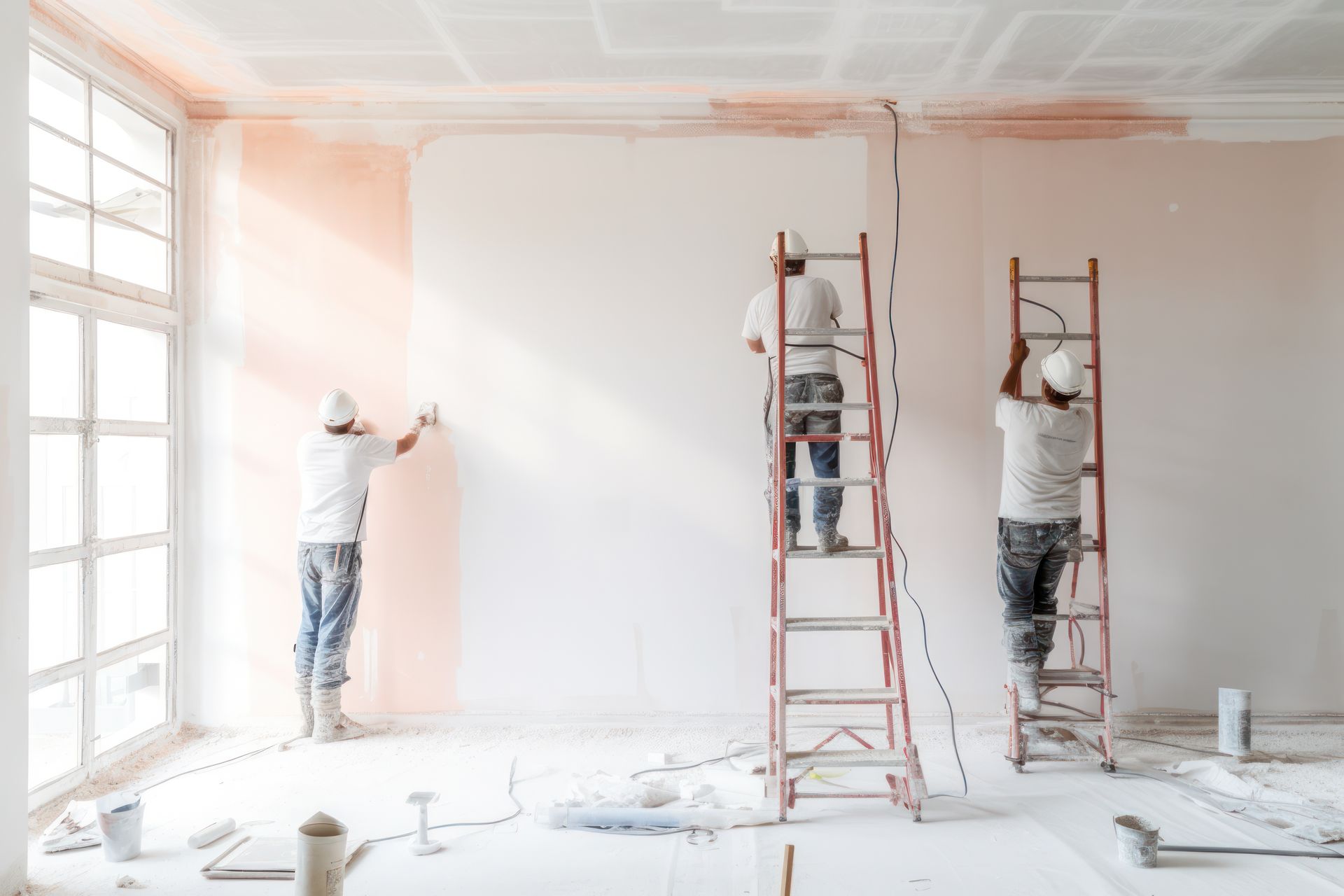If you own a home in Dallas built before 1978, there's a significant possibility that lead-based paint lurks beneath layers of newer paint throughout your house. This reality affects thousands of homeowners across the Dallas-Fort Worth metroplex, where charming older neighborhoods like Lakewood, Kessler Park, and East Dallas contain beautiful homes that predate federal lead paint regulations. Understanding how to safely manage lead paint while achieving your decorating goals requires knowledge, planning, and often professional expertise to protect your family's health and comply with federal regulations.
The presence of lead paint in your home doesn't automatically create a health emergency, but it does require careful consideration before undertaking any painting or renovation projects. Lead paint that remains intact and in good condition typically poses minimal risk to occupants. However, disturbing lead paint through scraping, sanding, or demolition can create dangerous lead dust that poses serious health risks, particularly to children and pregnant women. This means that the simple act of repainting your home becomes a complex decision requiring careful evaluation and proper safety protocols.
Many Dallas homeowners discover lead paint issues when they're ready to refresh their home's appearance or prepare for a major renovation. The good news is that you can absolutely paint over lead paint safely when proper procedures are followed. In fact, encapsulation through painting represents one of the most cost-effective and practical solutions for managing lead paint in older homes. However, success depends on understanding when encapsulation is appropriate, how to execute it properly, and when professional intervention becomes necessary.
Understanding Lead Paint in Dallas-Area Homes
Lead-based paint was widely used in American homes until its ban for residential use in 1978, meaning any home built before this date potentially contains lead paint. In Dallas, this encompasses a substantial portion of the housing stock, including historic neighborhoods that define much of the city's character. The older your home, the higher the likelihood and concentration of lead paint, with homes built before 1950 having an extremely high probability of containing lead-based paint throughout both interior and exterior surfaces.
Lead paint doesn't look different from regular paint, and you cannot determine its presence through visual inspection alone. Professional testing is the only reliable way to confirm whether your home contains lead-based paint. This testing can be performed through do-it-yourself test kits available at hardware stores, though these provide only preliminary results, or through professional lead inspections that offer comprehensive analysis and documentation required for certain renovation projects.
The Environmental Protection Agency requires that contractors working on homes built before 1978 follow specific lead-safe work practices, known as the RRP (Renovation, Repair, and Painting) Rule. This regulation affects any renovation project that disturbs more than six square feet of painted surface in a room or more than twenty square feet on exterior surfaces. Understanding these requirements helps homeowners recognize when professional intervention becomes legally necessary rather than simply advisable.
Lead contamination in Dallas homes often concentrates in specific areas where paint experiences the most wear and friction. Windows and door frames represent high-risk areas because the constant opening and closing creates friction that generates lead dust. Stairs, railings, and trim work also show elevated lead levels due to frequent contact and wear. Exterior surfaces, particularly those facing south and west, may have higher lead concentrations due to multiple paint layers applied over decades of weather protection.
Health Risks and Safety Considerations
Lead exposure poses serious health risks that make proper handling of lead paint crucial for protecting your family. Children under six years old face the greatest danger because their developing nervous systems are particularly vulnerable to lead's toxic effects. Even small amounts of lead exposure can cause learning disabilities, behavioral problems, and developmental delays that may persist throughout a child's life. Pregnant women must also exercise extreme caution, as lead exposure can affect fetal development and cause complications during pregnancy.
Adults aren't immune to lead's health effects, though they generally require higher exposure levels to experience symptoms. Lead poisoning in adults can cause high blood pressure, kidney problems, reproductive issues, and memory difficulties. For Dallas homeowners planning renovation projects, understanding these risks helps prioritize safety measures and professional consultation when working around potential lead paint.
Lead dust represents the primary exposure pathway in homes with lead paint. This invisible hazard can contaminate household surfaces, carpets, and even clothing when lead paint is disturbed through renovation activities. Normal cleaning methods don't effectively remove lead dust, requiring specialized cleaning techniques and equipment to ensure safe removal. This is why proper containment and cleanup become critical components of any project involving potential lead paint disturbance.
The good news is that lead paint in good condition poses minimal immediate risk. Paint that remains intact and well-adhered doesn't release lead dust under normal circumstances. However, peeling, chipping, or chalking paint creates immediate hazards that require prompt attention. Additionally, any renovation activity that could disturb lead paint transforms a stable situation into a potential health emergency without proper precautions.
When You Can Safely Paint Over Lead Paint
Encapsulation through painting represents an EPA-approved method for managing lead paint when specific conditions are met. This approach covers lead paint with new layers that prevent lead dust release while providing the fresh appearance homeowners seek. However, encapsulation isn't appropriate for all situations and requires careful evaluation of surface conditions and proper execution to ensure effectiveness.
The underlying lead paint must be in good condition for encapsulation to work properly. This means the surface should be stable, well-adhered, and free from peeling, chipping, or chalking. Any areas showing paint failure must be addressed before encapsulation, but this remediation must follow lead-safe work practices to prevent contamination. Professional assessment helps determine whether your specific surfaces qualify for encapsulation or require more extensive remediation.
Surface preparation for encapsulation differs significantly from standard painting preparation. While regular painting projects might involve sanding or scraping to create smooth surfaces, lead paint encapsulation requires minimal disturbance to avoid creating lead dust. Instead, preparation focuses on cleaning with appropriate methods, making minor repairs using lead-safe techniques, and ensuring surfaces are sound enough to support new paint layers.
The paint products used for encapsulation must meet specific performance standards to ensure they provide adequate barriers between lead paint and living spaces. Standard wall paint isn't sufficient for lead paint encapsulation. Instead, specialized encapsulant coatings are designed to create durable, long-lasting barriers that prevent lead dust release even if the coating experiences minor damage. These products typically cost more than regular paint but provide the performance necessary for safe lead paint management.
Professional application often makes the difference between successful encapsulation and failed attempts that create more problems than they solve. Contractors certified in lead-safe work practices understand the specific techniques required for encapsulation, including proper surface preparation, product selection, application methods, and cleanup procedures that prevent lead contamination during the process.
Situations Requiring Professional Lead Abatement
While encapsulation works well for stable lead paint, certain conditions require complete lead paint removal through professional abatement. Paint that's extensively deteriorated, surfaces subject to high wear or friction, and areas where encapsulation isn't practical need professional intervention. Attempting to handle these situations without proper training and equipment creates serious health risks and potential legal liability.
Friction surfaces like window sashes, door frames, and stair treads typically require abatement rather than encapsulation because the constant movement and contact will eventually wear through encapsulant coatings, exposing the lead paint underneath. These areas need complete lead paint removal to ensure long-term safety. Professional abatement contractors have specialized tools and techniques for safely removing lead paint from these challenging surfaces.
Extensively damaged surfaces with widespread peeling, chalking, or flaking lead paint aren't candidates for encapsulation. Attempting to paint over severely deteriorated lead paint won't provide adequate protection and may actually make the problem worse by creating false confidence while lead hazards persist. These situations require complete paint removal and surface restoration before new paint application.
Water damage that affects lead-painted surfaces often necessitates professional abatement because moisture compromises paint adhesion and can cause extensive lead paint failure. Dallas homes that have experienced roof leaks, plumbing failures, or flooding may have widespread lead paint damage that encapsulation cannot address effectively. Professional assessment helps determine the extent of damage and appropriate remediation approaches.
Renovation projects that involve structural changes, major demolition, or extensive surface disturbance trigger federal RRP requirements that mandate certified contractor involvement. These regulations aren't suggestions—they're legal requirements with significant penalties for non-compliance. Homeowners who attempt major renovation projects involving lead paint without proper certifications and procedures face potential fines and liability for any contamination that results.
Legal Requirements and Compliance
Federal law requires specific disclosures and procedures when dealing with lead paint in residential properties. The Lead Disclosure Rule mandates that sellers and landlords inform buyers and tenants about known lead paint hazards before sale or lease. This means that if you know your home contains lead paint, you must disclose this information to potential buyers when you eventually sell.
The RRP Rule requires that contractors working on homes built before 1978 be certified in lead-safe work practices and follow specific procedures to prevent lead contamination. This applies to any renovation project that disturbs painted surfaces beyond minimal thresholds. Homeowners can perform their own work on their own residences without certification, but they must follow the same safety procedures and are liable for any contamination that results.
Documentation becomes important for both compliance and future reference. Professional lead testing provides official documentation of lead paint presence or absence that satisfies disclosure requirements and helps plan future renovation projects. Similarly, professional abatement or encapsulation work should be thoroughly documented to demonstrate compliance with regulations and provide records for future homeowners.
Local Dallas building codes may impose additional requirements beyond federal regulations, particularly for properties in historic districts or those undergoing major renovations. Checking with local building officials before beginning lead paint work ensures compliance with all applicable regulations and helps avoid complications during permit reviews or inspections.
Practical Steps for Dallas Homeowners
If you suspect your Dallas home contains lead paint, start with professional testing to confirm its presence and extent. This investment provides the information necessary to make informed decisions about renovation projects and helps prioritize areas that need immediate attention versus those that can be managed through routine maintenance.
Develop a long-term management plan that addresses lead paint hazards while meeting your family's needs for home improvements and maintenance. This plan might include immediate encapsulation of high-risk areas, scheduling professional abatement for surfaces that require it, and establishing maintenance procedures that prevent lead paint deterioration over time.
Choose qualified professionals for any work involving confirmed or suspected lead paint. Verify that contractors hold appropriate certifications, carry adequate insurance, and have experience with lead paint projects. The lowest bid isn't necessarily the best value when safety and legal compliance are at stake.
Establish ongoing maintenance procedures that protect encapsulated lead paint and prevent future hazards. This includes regular inspection of painted surfaces, prompt repair of any damage that exposes underlying layers, and careful planning of future renovation projects to maintain compliance with lead safety requirements.
Cost Considerations and Planning
Lead paint management costs vary significantly depending on the approach chosen and the extent of work required. Simple encapsulation projects may cost only modestly more than standard painting, while comprehensive abatement can represent major investment. However, the costs of not addressing lead hazards—including potential health impacts and legal liability—often exceed the investment in proper remediation.
Professional testing costs typically range from a few hundred to over a thousand dollars depending on home size and the extent of testing required. This upfront investment provides crucial information for planning all future renovation work and may identify priority areas that need immediate attention to protect family health.
Encapsulation projects generally cost 25-50% more than standard painting due to specialized materials and procedures required. Professional abatement costs significantly more but may be necessary for certain surfaces or extensive lead paint problems. Getting multiple quotes from certified contractors helps establish realistic budgets and ensures competitive pricing.
Insurance considerations affect both the cost and planning of lead paint work. Some homeowner's insurance policies exclude coverage for lead contamination, making professional execution even more important to prevent problems that could result in expensive cleanup and potential health claims. Verify your coverage and consider additional protection if significant lead paint work is planned.
Making Informed Decisions
Managing lead paint in older Dallas homes requires balancing safety, compliance, aesthetics, and budget considerations. The key lies in professional assessment that provides accurate information about your specific situation, followed by careful planning that addresses immediate risks while supporting long-term home improvement goals.
Remember that lead paint isn't an emergency if it's in good condition, but it becomes a serious hazard when disturbed improperly. Taking time to understand your options, obtain professional consultation, and plan work carefully prevents both health risks and unnecessary expenses while achieving your goals for your home's appearance and safety.
Ready to address lead paint concerns in your Dallas-area home safely and effectively? Hutch'N'Son Painting has served the Dallas-Fort Worth metroplex since 1985, with extensive experience in lead-safe work practices and specialized techniques for managing lead paint in older homes. Our certified professionals can assess your specific situation, explain your options, and execute appropriate solutions that protect your family while achieving your aesthetic goals. We understand the unique challenges of Dallas-area homes built before 1978 and provide the expertise necessary to navigate federal regulations while delivering the quality results you expect. Contact us today to schedule your consultation and discover how we can help you safely manage lead paint while transforming your home's appearance.






